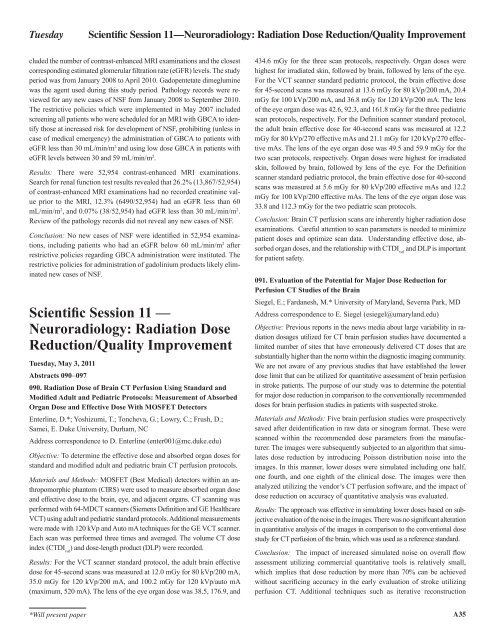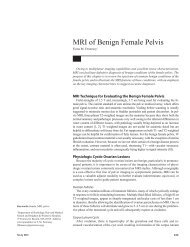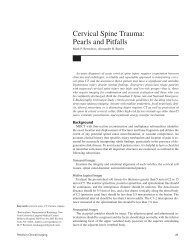Scientific Session 1 â Breast Imaging: Mammography
Scientific Session 1 â Breast Imaging: Mammography
Scientific Session 1 â Breast Imaging: Mammography
You also want an ePaper? Increase the reach of your titles
YUMPU automatically turns print PDFs into web optimized ePapers that Google loves.
Tuesday<strong>Scientific</strong> <strong>Session</strong> 11—Neuroradiology: Radiation Dose Reduction/Quality Improvementcluded the number of contrast-enhanced MRI examinations and the closestcorresponding estimated glomerular filtration rate (eGFR) levels. The studyperiod was from January 2008 to April 2010. Gadopentetate dimegluminewas the agent used during this study period. Pathology records were reviewedfor any new cases of NSF from January 2008 to September 2010.The restrictive policies which were implemented in May 2007 includedscreening all patients who were scheduled for an MRI with GBCA to identifythose at increased risk for development of NSF, prohibiting (unless incase of medical emergency) the administration of GBCA to patients witheGFR less than 30 mL/min/m 2 and using low dose GBCA in patients witheGFR levels between 30 and 59 mL/min/m 2 .Results: There were 52,954 contrast-enhanced MRI examinations.Search for renal function test results revealed that 26.2% (13,867/52,954)of contrast-enhanced MRI examinations had no recorded creatinine valueprior to the MRI, 12.3% (6490/52,954) had an eGFR less than 60mL/min/m 2 , and 0.07% (38/52,954) had eGFR less than 30 mL/min/m 2 .Review of the pathology records did not reveal any new cases of NSF.Conclusion: No new cases of NSF were identified in 52,954 examinations,including patients who had an eGFR below 60 mL/min/m 2 afterrestrictive policies regarding GBCA administration were instituted. Therestrictive policies for administration of gadolinium products likely eliminatednew cases of NSF.<strong>Scientific</strong> <strong>Session</strong> 11 —Neuroradiology: Radiation DoseReduction/Quality ImprovementTuesday, May 3, 2011Abstracts 090-097090. Radiation Dose of Brain CT Perfusion Using Standard andModified Adult and Pediatric Protocols: Measurement of AbsorbedOrgan Dose and Effective Dose With MOSFET DetectorsEnterline, D.*; Yoshizumi, T.; Toncheva, G.; Lowry, C.; Frush, D.;Samei, E. Duke University, Durham, NCAddress correspondence to D. Enterline (enter001@mc.duke.edu)Objective: To determine the effective dose and absorbed organ doses forstandard and modified adult and pediatric brain CT perfusion protocols.Materials and Methods: MOSFET (Best Medical) detectors within an anthropomorphicphantom (CIRS) were used to measure absorbed organ doseand effective dose to the brain, eye, and adjacent organs. CT scanning wasperformed with 64-MDCT scanners (Siemens Definition and GE HealthcareVCT) using adult and pediatric standard protocols. Additional measurementswere made with 120 kVp and Auto mA techniques for the GE VCT scanner.Each scan was performed three times and averaged. The volume CT doseindex (CTDI vol) and dose-length product (DLP) were recorded.Results: For the VCT scanner standard protocol, the adult brain effectivedose for 45-second scans was measured at 12.0 mGy for 80 kVp/200 mA,35.0 mGy for 120 kVp/200 mA, and 100.2 mGy for 120 kVp/auto mA(maximum, 520 mA). The lens of the eye organ dose was 38.5, 176.9, and434.6 mGy for the three scan protocols, respectively. Organ doses werehighest for irradiated skin, followed by brain, followed by lens of the eye.For the VCT scanner standard pediatric protocol, the brain effective dosefor 45-second scans was measured at 13.6 mGy for 80 kVp/200 mA, 20.4mGy for 100 kVp/200 mA, and 36.8 mGy for 120 kVp/200 mA. The lensof the eye organ dose was 42.6, 92.3, and 161.8 mGy for the three pediatricscan protocols, respectively. For the Definition scanner standard protocol,the adult brain effective dose for 40-second scans was measured at 12.2mGy for 80 kVp/270 effective mAs and 21.1 mGy for 120 kVp/270 effectivemAs. The lens of the eye organ dose was 49.5 and 59.9 mGy for thetwo scan protocols, respectively. Organ doses were highest for irradiatedskin, followed by brain, followed by lens of the eye. For the Definitionscanner standard pediatric protocol, the brain effective dose for 40-secondscans was measured at 5.6 mGy for 80 kVp/200 effective mAs and 12.2mGy for 100 kVp/200 effective mAs. The lens of the eye organ dose was33.8 and 112.3 mGy for the two pediatric scan protocols.Conclusion: Brain CT perfusion scans are inherently higher radiation doseexaminations. Careful attention to scan parameters is needed to minimizepatient doses and optimize scan data. Understanding effective dose, absorbedorgan doses, and the relationship with CTDI voland DLP is importantfor patient safety.091. Evaluation of the Potential for Major Dose Reduction forPerfusion CT Studies of the BrainSiegel, E.; Fardanesh, M.* University of Maryland, Severna Park, MDAddress correspondence to E. Siegel (esiegel@umaryland.edu)Objective: Previous reports in the news media about large variability in radiationdosages utilized for CT brain perfusion studies have documented alimited number of sites that have erroneously delivered CT doses that aresubstantially higher than the norm within the diagnostic imaging community.We are not aware of any previous studies that have established the lowerdose limit that can be utilized for quantitative assessment of brain perfusionin stroke patients. The purpose of our study was to determine the potentialfor major dose reduction in comparison to the conventionally recommendeddoses for brain perfusion studies in patients with suspected stroke.Materials and Methods: Five brain perfusion studies were prospectivelysaved after deidentification in raw data or sinogram format. These werescanned within the recommended dose parameters from the manufacturer.The images were subsequently subjected to an algorithm that simulatesdose reduction by introducing Poisson distribution noise into theimages. In this manner, lower doses were simulated including one half,one fourth, and one eighth of the clinical dose. The images were thenanalyzed utilizing the vendor’s CT perfusion software, and the impact ofdose reduction on accuracy of quantitative analysis was evaluated.Results: The approach was effective in simulating lower doses based on subjectiveevaluation of the noise in the images. There was no significant alterationin quantitative analysis of the images in comparison to the conventional dosestudy for CT perfusion of the brain, which was used as a reference standard.Conclusion: The impact of increased simulated noise on overall flowassessment utilizing commercial quantitative tools is relatively small,which implies that dose reduction by more than 70% can be achievedwithout sacrificing accuracy in the early evaluation of stroke utilizingperfusion CT. Additional techniques such as iterative reconstruction*Will present paperA35
















